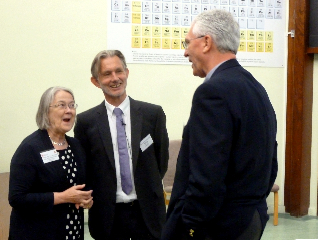I was at the University of Bristol, in Southwest England, last week to give the 43rd Annual Convocation Lecture. Convocation is the University of Bristol’s alumni association, and it was an honour and a pleasure to give a lecture to former colleagues and current students; I was at Bristol University from 1977 to 1982. The annual convocation lecture is an opportunity to meet old friends, make new acquaintances and listen to a presentation of an interesting topic.

University of Bristol Chancellor, Baroness Hale, speaking with the author and Bill Ray, Chair of the Convocation Committee
My talk was about Biodiversity in Europe, which was particularly relevant as the event took place on 22 May – the International day of Biodiversity. Earlier in the day, Sir David Attenborough had launched the UK State of Nature report, a stocktake of UK nature which suggests that 60% of animal and plant species studied have declined in the past 50 years. Sir David described the report as a stark warning, but also as a sign of hope as it highlights the amazing nature we have around us and to ensure that it remains here for generations to come.
I had a similar message about biodiversity in Europe; there are serious and effective conservation measures in place, but we are still losing biodiversity. There are some very powerful success stories, but the effectiveness of conservation is not the same across Europe.
My other message was that short-term economic interests often clash with long-term sustainable development objectives, and we need to balance conservation of nature and industrial production. Agriculture and fisheries are two particularly important sectors as they will have to provide some of the financial support for nature conservation in Europe.
Communication is extremely important, and I stressed that we need to simplify our messaging and use better marketing approaches to get the meaning across. One agreed approach which we should embrace is to use best practice examples and success stories to emphasize the positive side of nature conservation. We need to stress the beauty of nature and the many benefits we gain from a healthy environment, and try to generate stronger political support for what we do.
I made the case that local authorities and the private sector are two groups of society that have recently shown some very positive and exciting examples of nature conservation. Providing that they are serious, these are potential real game-changers.
My final point related to the need to get a closer and more effective collaboration between the academic institutions, the government and the NGOs working on biodiversity and nature.
Sir David is hopeful, and I also ended my talk with the recognition that there is a lot of good work going on, while pointing out that nature is resilient.




0 comments
Write a comment